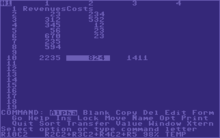Multiplan
  Screenshots of Multiplan on DOS (top) and the Commodore 64 (bottom). | |
| Developer(s) | Doug Klunder[1] of Microsoft[1] |
|---|---|
| Initial release | 1982 |
| Development status | Unmaintained since 1985 |
| Written in | p-code C |
| Operating system | CP/M, Apple II, Macintosh, MS-DOS, Xenix, Commodore 64, CTOS, TI-99/4A, TRS-80 |
| Type | Spreadsheet |
Multiplan was an early spreadsheet program developed by Microsoft. Known initially by the code name "EP" (for "Electronic Paper"), it was introduced in 1982 as a competitor for VisiCalc.
Multiplan was released first for computers running CP/M; it was developed using a Microsoft proprietary p-code C compiler[1] as part of a portability strategy that facilitated ports to systems such as MS-DOS, Xenix, Commodore 64 and 128, Texas Instruments TI-99/4A, Radio Shack TRS-80 Model II, TRS-80 Model 4, TRS-80 Model 100 (on ROM), Apple II, and Burroughs B-20 series.
Despite the release of Microsoft Chart, a graphics companion program, Multiplan continued to be outsold by Lotus 1-2-3. It was replaced by Microsoft Excel which followed some years later on both the Apple Macintosh (1985) and Microsoft Windows (1987).
Around 1983, during the development of the first release of Windows, Microsoft had plans to make a Windows version. However the plans changed a year later.[citation needed]
Macintosh version
Multiplan for the Apple Macintosh was Microsoft's first GUI spreadsheet; it was also the most successful spreadsheet for the early Mac.[citation needed]
Bill Gates was repeatedly heard in 1985 saying that Microsoft made more money on Multiplan for the Macintosh than any other platform. Multiplan for the Macintosh was in fact one of the few spreadsheets available for that platform. It was proficient at making graphs and charts and was often bundled with some Macs.[citation needed] However, Multiplan only lasted for about a year before being overtaken by the more successful Excel.
Version compatibility
The latest version of System Software that Multiplan 1.1 was tested with is System Software 2.0 which used System 4.1 and Finder 5.5. [2]
Cell addressing differences
A fundamental difference between Multiplan and its competitors was Microsoft's decision to use R1C1 addressing instead of the A1 addressing introduced by VisiCalc. As is the case with Reverse Polish notation, although R1C1-style formulas are more efficient than A1-style formulae[3] (for instance, relative and absolute references can be mixed in the same expression, as "R1C" to mean "row 1, this column"), most spreadsheet users prefer the A1 addressing style introduced by VisiCalc.[citation needed]
Microsoft carried Multiplan's R1C1 legacy forward into Microsoft Excel, which offers both addressing modes.
See also
References
- ↑ 1.0 1.1 1.2 Microsoft: The Early Days from the personal website of Richard Brodie
- ↑ http://support.apple.com/kb/TA45463?viewlocale=en_US
- ↑ VBA and Macros for Microsoft Excel by Bill Jelen & Tracy Syrstad, Chapter 6